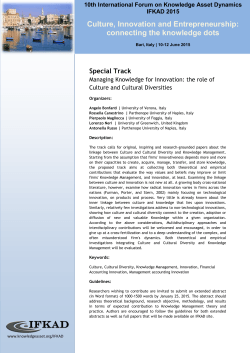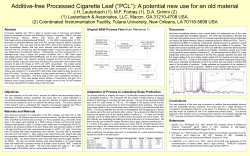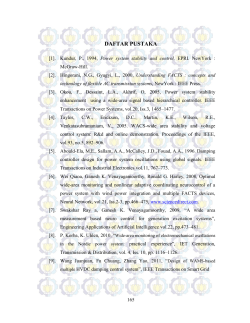
Temperature and pH Responsive Microfibers for Controllable and
Temperature and pH Responsive Microfibers for Controllable and Variable Ibuprofen Delivery Toan Trana+, Mariana Hernandeza+, Dhruvil Patela+, Ji Wua* Affiliation address: a Department of Chemistry, Georgia Southern University, 250 Forest Drive, Statesboro, GA 30460, USA + Authors contribute equally to this work. * Corresponding author: Prof. Ji Wu; Email: jwu@georgiasouthern.edu; The authors declare that there is no conflict of interests regarding the publication of this paper. 1 Abstract Electrospun microfibers (MFs) composed of pH and temperature responsive polymers can be used for controllable and variable delivery of ibuprofen. First, electrospinning technique was employed to prepare poly (ε-caprolactone) (PCL) and poly(N-isopropylacrylamide-co-methacrylic acid) (pNIPAM-co-MAA) MFs containing ibuprofen. It was found that drug release rates from PCL MFs cannot be significantly varied by either temperature (22-40 oC) or pH values (1.7-7.4). In contrast, the ibuprofen (IP) diffusion rates from pNIPAM-co-MAA MFs were very sensitive to changes in both temperature and pH. The IP release from pNIPAM-co-MAA MFs was highly linear and controllable when the temperature was above the lower critical solution temperature (LCST) of pNIPAM-co-MAA (33 oC) and the pH was lower than the pKa of carboxylic acids (pH2). At room temperature, however, the release rate was dramatically increased by nearly ten times compared to that at higher temperature and lower pH. Such a unique and controllable drug delivery system could be naturally envisioned to find many practical applications in biomedical and pharmaceutical sciences such as programmable transdermal drug delivery. Keywords poly (ε-caprolactone), poly(N-isopropylacrylamide-co-methacrylic acid), microfibers; ibuprofen; controlled diffusion; temperature and pH responsive 2 1. Introduction Controllable and programmable drug delivery systems have found many applications in medical and pharmaceutical sciences.[1, 2] Controlled drug delivery systems have been successfully applied to cancer treatments and tissue engineering with a better improved efficacy.[3-5] However, there are still two major challenges to overcome 1) reducing initial burst effects and 2) realizing a programmable drug delivery.[6, 7] In the past decade, multiple technologies have been proposed and developed, purposing to solve or partially relieve the above mentioned challenges.[7-12] For example, electrospinning technology is deemed as one of those most facile and lowcost methods to produce nano- and micro-materials with many novel functionalities. Drug delivery rates from these electrospun fibers can be manipulated by controlling the diameter, materials, structures, compositions, etc.[5] The relative large specific surface area of these materials can also benefit an enhanced solubility for most hydrophobic potent drugs. In addition, various co-axial electrospinning techniques have been adopted to realize a controllable protein delivery with minimum burst effect (protein-core and cellulose acetate shell).[13-15] Poly-(N-isopropylacrylamide-co-methacrylicacid) (PNIPAM-co-MAA) is an interesting polymer that is responsive to both pH and temperature changes. This type of polymers is biocompatible and has been explored widely in drug delivery and tissue engineering.[16-18] When heated above its lower critical solution temperature (LCST), the polymer undergoes a reversible phase transition from hydrophilic to hydrophobic, leading to the change of drug release rates.[19] In addition, when the pH is below the pKa of carboxylic acid (such as pH 2), the polymer becomes more hydrophobic due to the protonation of carboxyl groups.[20] Although PNIPAM has been fabricated into various particle formulations for drug delivery, very few studies 3 have been reported using PNIPAM-co-MAA microfibers as drug delivery vehicles. p(NIPAAm-co-PAA) micro-gel was used as a host material to deliver the basic fibroblast growth factor (bFGF).[21] It was found that the release rate of bFGF was much higher at pH 7.4 compared to pH 5 because the carboxylic acid is deprotonated at higher pH, thus making the polymer more hydrophilic. Thereby water can permeate more easily into the polymeric matrix and result in a faster diffusion rate.[21] Very recently, pNIPAAm-co-pAAm copolymer was used to mask a peptide ligand that binds a widely distributed receptor (integrin β1) on the surface of silica core–gold shell nanoparticles. Because gold is an efficient near infrared (NIR) absorber, NIR photons can be employed to manipulate the temperature of nanoparticles, leading to the collapse of pNIPAAm-co-pAAm copolymer mask layer and resulting a targeting drug delivery.[22] It was reported that electrospun PNIPAMco-MAA fibers can be employed as scaffolds for tissue engineering, demonstrating excellent cell compatibility.[17] Poly vinyl alcohol (PVA) and pNIPAM co-electrospun fibers containing levothyroxine were used for transdermal delivery by Azarbayjani et al., showing a certain degree of burst effects.[23] Noteworthy, burst effects were observed under the conditions they investigated, probably because the drug is highly hydrophilic. In this study, we fabricated pNIPAM-co-MAA electrospun microfibers loaded with hydrophobic ibuprofen drug molecules and investigated the possibility to control the drug delivery rates and burst effects by varying pH values and temperatures for potential pharmaceutical applications, which work has never been reported to the best of our knowledge. Electrospun poly (ε-caprolactone) (PCL) microfibers were also studied for comparison. It was found that controlled and variable release of ibuprofen from pNIPAM-co-MAA can be obtained by applying temperature and pH as stimuli, 4 whereas the ibuprofen release rates from PCL fibers are not responsive to these stimuli at all. 2. Materials and Methods 2.1. Materials PCL with an average Mn of 45,000 and pNIPAM-co-MAA with an average Mn of 30,000-50,000 were purchased from Sigma-Aldrich. PCL pellets were sold in 100 g contained in a poly bottle, whose melting point ranges from 56-64 °C. pNIPAM-co-MAA powder with 5 mol % in methacrylic acid was sold in 5 g hold in a glass vial, whose melting point is higher than 300 oC. The pNIPAM-coMAA polymer has a lower critical solubility temperature (LCST) of ~33 oC. Ibuprofen (IP) powder with a purity >99.0% was obtained from ACROS Organic. Ethanol and acetone with purity higher than 99.5% were purchased from EMD Millipore. Acetonitrile used for HPLC analysis was purchased from EMD Millipore also. 2.2. Fabrication of Microfibers: Two types of microfibers (MFs) (PCL and pNIPAM-co-MAA) containing ibuprofen were fabricated using a homebuilt electrospinning setup (Figure 1a). The electrospinning working parameters for MFs were as follows: applied voltage was direct current (DC) 25 kV (Spellman P/N230-30R); distance between the syringe needle (16 gauge, Air-Tite Products Co.) containing the solution and the grounding collector (aluminum foil) was 10 cm; and pumping rate of syringe was 4 ml/hr. The syringe pump was purchased from New Era Pump Systems Inc. (NE-1000). Fabrication of PCL/IP MFs: First, 50 mg IP and 1.0 g PCL pellets were dissolved in 10 mL acetone under magnetic stirring and sonication. Then the solution was electrospun into PCL/IP MFs using a single nozzle spinerret. Notewothy, it is very difficult to dissolve more than 10% 5 w/v PCL in actone. Although the solubility of PCL can be enhanced uisng more toxic organic solvents such as DMF, it would raise safety concerns when they are applied to pharmaceutical and biomedical devices becasue residual solvent molecules could be trapped in these MFs. Fabrication of pNIPAM-coMAA MFs: 50 mg IP and 1.0 g pNIPAM-co-MAA powders were dissolved in 5.0 mL ethanol under magnetic stirring. Then the solution was used to fabricate pNIPAM-co-MAA MFs using a single nozzle spinneret. A high w/v percentage was used to form pNIPAM-co-MAA microfibers due to its relatively low viscosity. 2.3. Characterization of Microfibers As-prepared samples were characterized using a Field Emission Electron Microscopy (JEOL JSM-7600F) at Georgia Southern University for morphology examinations. Fourier-Transform Infrared (FTIR) spectra of microfiber samples were recorded in the attenuated total reflection (ATR) mode using an IR spectrophotometer (Thermo-Nicolet AVATAR 370 FT-IR Spectrometer) in the range of 4000 to 650 cm-1 at Georgia Southern University. Micromeritics ASAP 2020 Surface Area and Porosimetry Analyzer was used to measure the surface area of MFs using the 5-point Brunauer-Emmett-Teller (BET) method with nitrogen gas adsorption. 2.4. Drug diffusion studies All ibuprofen studies involving the two types of MFs were carried out using a 5ml PermeGear Franz cell (Figure 1b) with a 10 mm diameter orifice for sampling. ~20 ± 1 mg MFs were wetted and suspended in the receptor chamber containing 4.0 mL of pH 7.4 distill water or pH 1.7 aqueous solution. The pH 1.7 acidic solutions were prepared by dissolving 0.74 g KCl and 1mL concentrated HCl in 1 L deionized water. Magnetic stirring bar was used during 6 the drug diffusion studies. 1 mL solution was pipetted from the receiver chamber per hour and stored into 1.8 mL amber glass vials for HPLC analysis. The chamber was back-filled with 1.0 mL deionized water after each sampling. All drug release profiles were averaged from triple measurements. 2.5. HPLC measurements and data analysis All ibuprofen samples were analyzed by a Shimadzu LCAT High Performance Liquid Chromatography (HPLC) consisting of a SIL-20AHT autosampler, a LC20AT HPLC pump, a SPD-20A dual UV/Vis absorbance detector set at a wavelength of 254 nm and utilizing LabSolutions software. Thermo Scientific (250 mm x 4 mm; L x I.D.) was used for the separation. The mobile phase consisted of 0.1 wt% H3PO4 aqueous solution: acetonitrile (55:45) and flow rate of 1.0mL/min. Calibration plots were prepared using IP standards with concentrations over a range of 20-100 ppm. The correlation coefficient (r2) obtained was ≥0.99 for standard curves. The cumulative quantity of drug collected in the receiver compartment was plotted as a function of time. 3. Results and Discussion Figure2 shows that the average diameter of PCL/IP MFs was ~1237 nm with a large standard deviation of 422 nm. The average diameter of bifunctional pNIPAM-co-MAA microfibers was ~1608 nm with a standard deviation of 444 nm (Figure 2). Notablly, there were no apparent drug particles on the surface of these MFs, which can help reduce the burst effect due to the quick dissolution of these surface drug molecules. Surface area analysis show that the specific surface area of PCL/IP and pNIPAM-co-MAA/IP MFs are 0.974 and 0.662 m2 g-1, respectively, which are highly consitent with their SEM data (1237 and 1608 nm in diameter) and literature reported value.[24] 7 Table 1 Surface area of PCL/IP and pNIPAM-co-MAA/IP MFs. Sample PCL/IP MFs pNIPAM-co-MAA/IP MFs Surface Area (m2 g-1) 0.974±0.036 0.662±0.104 Fourier transform infrared (FTIR) spectroscopy (Figure 3) was utilized to characterize these MF samples. PCL finger print peak at 2948 cm-1 is derived from asymmetric CH2 stretching.[25] Strong peaks at 1736 cm−1 and 1176 cm−1 can be assigned to C=O and C-O stretchings, respectively.[26] In the FTIR spectrum of pNIPAM-co-MAA/IP microfibers, characteristic peaks of pNIPAM located at 1650 and 1558 cm-1 can be assigned to amide carbonyl stretching and amide N-H bending, respectively.[27] Carbonyl stretching from MAA carboxylic acid groups can be seen at 1716 cm-1. C-O stretching peak at 1172 cm-1 was also observed. For better comparison, FTIR spectra of pure PCL, IP and pNIPAM-co-MAA were also shown in Figure 3. The IP peaks can’t be clearly identified due to its low weight percentage (5 wt%) and the significant overlapping with other polymers (Figure3). The diffusion rates of ibuprofen from two types of MFs were investigated at 22 and 40 oC and pH 1.7 and 7.4 (Figure 4). It can be seen that 0.85 µmol of ibuprofen was quickly released from pNIPAM-co-MAA/IP MFs in the first one hour at 22 0C an pH 7.4, and then the rest was released at a much slower rate, 0.29 µmol hr-1. Similarly, ibuprofen was released at a rate of 0.97 µmol hr-1 in the first two hours at pH 1.7 and 22 oC, which was then followed by a slower rate of 0.54 µmol hr-1. Because the LCST of pNIPAM-co-MAA is ~33 oC, the polymer is quite hydrophilic at 22 oC. So water can easily permeate through the polymer matrix, resulting in a fast diffusion rate. In contrast, IP was released at 8 a much slower rate when the temperature was increased to 40 0C. The average release rate was only 0.09 µmol hr-1 at pH 7.4 and 40 oC. It is because pNIPAM-co-MAA became much more hydrophobic above its LCST, and thus functioned like a drug depot to prohibit the fast release of hydrophobic IP molecules. This rate was ~ 10 times slower than that at room temperatures. In addtion, the standard deviation bar is also smaller, indicating the drug delivery is more repeatable at high temperature using pNIPAM-co-MAA as the host material. At pH 1.7 and 40 oC, the drug release rate of IP from pNIPAM-coMAA MFs was even slower (0.05 µmol hr-1) and there was no burst effect. It is because when the pH was lower than the pKa of carboxylic acid the carboxyl groups of the polymer was protonated, making the polymer even more hydrophobic. Thereby the hydrophobic IP release rate was further reduced and better controlled. It should be pointed out that although PNIPAM-co-MAA is biodegradable in the presence of catalytic enzymes, the rate is quite slow (several percent by weight in 3 days).[28] Our diffusion time was only 4 hours and there were no catalytic enzymes. Thereby, the effect of biodegradation on drug diffusion rates is negligible. We also believe the release of ibuprofen is mainly from the passive diffusion through PNIPAM-co-MAA microfiber matrix. No drug particles were observed on the surface or in between the fibers under SEM imaging, indicating ibuprofen was not released through the interconnected microfiber networks. In dramatic constrast, the IP release from PCL/IP MFs was not sensitive to either pH or temperature changes (Figure 4) because PCL molecules have no functional groups that can respond to either pH and temperature stimuli. The average release rate of IP was ~ 0.2 µmol hr-1 and there was a serious burst effect in the first one hour. The diffusion rate of ibuprofen from PCL MFs was 9 slower at room temperature and pH 1.7. It is because the IP was protonated at such a low pH and thus had a low solubility, leading to a slower diffusion rate. Additionally, IP drug molecules would diffuse more slowly at lower temperatures as governed by thermodynamics. Notably, the relative large standard deviation bar may be due to the bundling of these MFs, which can affect the diffusion rates. But the trend remains similar for all measurements. 4. Conclusion Two types of polymeric microfibers with dramatically different drug release behaviors were fabricated using a simple electrospinning method. It was found that both pH and temperature have negligible effects on the IP diffusion rates from PCL/IP MFs. In dark contrast, the ibuprofen release rates from pNIPAMco-MAA MFs are highly controllable with minimum burst effect, owing to the synergetic effects of both pH and temperature. Ibuprofen release rates from pNIPAM-co-MAA MFs is also highly switchable, i.e. the release rate of IP at 22 oC was ~ 10 times faster than that at 40 oC. Such a unique controllable drug delivery system have many potential applications in biomedical and pharmaceutical sciences with a highly efficient treatment efficacy. 5. Acknowledgements The financial support provided by the Georgia Southern University is sincerely acknowledged by JW, MH, TT and DP. We also deeply appreciate the Department of Chemistry at GSU for infrastructure supports. 6. References 1. R. Langer, "Drug delivery and targeting," Nature, vol. 392, no. 6679 Suppl, pp. 510, 1998. 2. T. Bussemer, I. Otto and R. Bodmeier, "Pulsatile Drug-Delivery Systems," Crit Rev Ther Drug Carrier Syst., vol. 18, no. 5, pp. 26, 2001. 3. T. M. Allen and P. R. Cullis, "Drug Delivery Systems: Entering the Mainstream," Science, vol. 303, no. 5665, pp. 1818-1822, 2004. 10 4. W. M. Saltzman and W. L. Olbricht, "Building drug delivery into tissue engineering," Nature Reviews Drug Discovery, vol. 1, no. 3, pp. 177-186, 2002. 5. T. J. Sill and H. A. von Recum, "Electrospinning: Applications in drug delivery and tissue engineering," Biomaterials, vol. 29, no. 13, pp. 1989-2006, 2008. 6. D. A. LaVan, T. McGuire and R. Langer, "Small-scale systems for in vivo drug delivery," Nature biotechnology, vol. 21, no. 10, pp. 1184-1191, 2003. 7. J. Wu, K. S. Paudel, C. Strasinger, D. Hammell, A. L. Stinchcomb and B. J. Hinds, "Programmable transdermal drug delivery of nicotine using carbon nanotube membranes," Proceedings of the National Academy of Sciences, vol. 107, no. 26, pp. 11698–11702 , 2010. 8. O. C. Farokhzad and R. Langer, "Impact of Nanotechnology on Drug Delivery," ACS Nano, vol. 3, no. 1, pp. 16-20, 2009. 9. K. Park, "Nanotechnology: What it can do for drug delivery," Journal of Controlled Release, vol. 120, no. 1-2, pp. 1-3, 2007. 10. S. Suri, H. Fenniri and B. Singh, "Nanotechnology-based drug delivery systems," Journal of Occupational Medicine and Toxicology, vol. 2, no. 1, pp. 16, 2007. 11. C. Strasinger, K. S. Paudel, J. Wu, D. Hammell, R. R. Pinninti, B. J. Hinds and A. Stinchcomb, "Programmable Transdermal Clonidine Delivery Through Voltage-Gated Carbon Nanotube Membranes," Journal of Pharmaceutical Sciences, vol. 103, no. 6, pp. 1829-1838, 2014. 12. K. S. Paudel, J. Wu, B. J. Hinds and A. L. Stinchcomb, "Programmable transdermal delivery of nicotine in hairless guinea pigs using carbon nanotube membrane pumps," Journal of Pharmaceutical Sciences, vol. 101, no. 10, pp. 38233832, 2012. 13. Y. Li, L. T. Lim and Y. Kakuda, "Electrospun Zein Fibers as Carriers to Stabilize (−)-Epigallocatechin Gallate," Journal of Food Science, vol. 74, no. 3, pp. C233C240, 2009. 14. T. Kiatyongchai, S. Wongsasulak and T. Yoovidhya, "Coaxial electrospinning and release characteristics of cellulose acetate–gelatin blend encapsulating a model drug," Journal of Applied Polymer Science, vol. 131, no. 8, pp. 40167, 2014. 15. S. Sakuldao, T. Yoovidhya and S. Wongsasulak, "Coaxial electrospinning and sustained release properties of gelatin-cellulose acetate core-shell ultrafine fibres," ScienceAsia, vol. 37, no. 4, pp. 335-343, 2011. 16. M. Constantin, S. Bucatariu, V. Harabagiu, I. Popescu, P. Ascenzi and G. Fundueanu, "Poly(N-isopropylacrylamide-co-methacrylic acid) pH/thermo-responsive porous hydrogels as self-regulated drug delivery system," European Journal of Pharmaceutical Sciences, vol.62, no.0, pp. 86–95, 2014. 17. Y. Sharma, A. Tiwari, S. Hattori, D. Terada, A. K. Sharma, M. Ramalingam and H. Kobayashi, "Fabrication of conducting electrospun nanofibers scaffold for threedimensional cells culture," International Journal of Biological Macromolecules, vol. 51, no. 4, pp. 627-631, 2012. 18. Y. Qiu and K. Park, "Environment-sensitive hydrogels for drug delivery," Advanced Drug Delivery Reviews, vol. 53, no. 3, pp. 321-339, 2001. 19. B. S. Forney, C. Baguenard and C. A. Guymon, "Improved stimuli-response and mechanical properties of nanostructured poly(N-isopropylacrylamide-codimethylsiloxane) hydrogels generated through photopolymerization in lyotropic liquid crystal templates," Soft Matter, vol. 9, no. 31, pp. 7458-7467, 2013. 20. P. Tian, Q. Wu and K. Lian, "Preparation of temperature- and pH-sensitive, stimuli-responsive poly(N-isopropylacrylamide-co-methacrylic acid) nanoparticles," Journal of Applied Polymer Science, vol. 108, no. 4, pp. 2226-2232, 2008. 11 21. J. C. Garbern, A. S. Hoffman and P. S. Stayton, "Injectable pH- and Temperature-Responsive Poly(N-isopropylacrylamide-co-propylacrylic acid) Copolymers for Delivery of Angiogenic Growth Factors," Biomacromolecules, vol. 11, no. 7, pp. 1833-1839, 2010. 22. A. Barhoumi, W. Wang, D. Zurakowski, R. S. Langer and D. S. Kohane, "Photothermally Targeted Thermosensitive Polymer-Masked Nanoparticles," Nano Letters, vol. 14, no. 7, pp. 3697-3701, 2014. 23. A. F. Azarbayjani, J. R. Venugopal, S. Ramakrishna, P. F. C. Lim, Y. W. Chan and S. Y. Chan, "Smart Polymeric Nanofibers for Topical Delivery of Levothyroxine," Journal of Pharmacy and Pharmaceutical Sciences, vol. 13, no. 3, pp. 400-410, 2010. 24. T. Grafe and K. Graham, Polymeric Nanofibers and Nanofiber Webs: A New Class of Nonwovens. NonwoVen Technol. ReV. pp. 51-55, 2003, Spring. 25. A. Elzubair, C. N. Elias, J. C. M. Suarez, H. P. Lopes and M. V. B. Vieira, "The physical characterization of a thermoplastic polymer for endodontic obturation," Journal of Dentistry, vol. 34, no. 10, pp. 784-789, 2006. 26. S. Garrigues, M. Gallignani and M. de la Guardia, "FIA—FT—IR determination of ibuprofen in pharmaceuticals," Talanta, vol. 40, no. 1, pp. 89-93, 1993. 27. D. Li, X. Zhang, J. Yao, G. P. Simon and H. Wang, "Stimuli-responsive polymer hydrogels as a new class of draw agent for forward osmosis desalination," Chemical Communications, vol. 47, no. 6, pp. 1710-1712, 2011. 28. D.-Q. Wu, F. Qiu, T. Wang, X.-J. Jiang, X.-Z. Zhang and R.-X. Zhuo, "Toward the Development of Partially Biodegradable and Injectable Thermoresponsive Hydrogels for Potential Biomedical Applications," ACS Applied Materials & Interfaces, vol. 1, no. 2, pp. 319-327, 2008. 12 a b Figure 1. Schematic of a) the electrospinning setup for the fabrication of PCL and pNIPAM-co-MAA MFs containing ibuprofen; b) the Franz diffusion cell used for the drug diffusion studies. 13 b a Scale bar = 1 µm Scale bar = 1 µm d c Number of NFs Number of NFs PCL/IP MFs 18 Average=1237 nm; std=422 nm 17 16 15 14 13 12 11 10 9 8 7 6 5 4 3 2 1 0 400 600 800 1000 1200 1400 1600 1800 2000 2200 2400 pNIPAM-co-MAA/IP MFs 18 17 Average=1608 nm; std=444 nm 16 15 14 13 12 11 10 9 8 7 6 5 4 3 2 1 0 400 600 800 1000 1200 1400 1600 1800 2000 2200 2400 Diameter of NFs (nm) Diameter of NFs (nm) Figure 2. Scanning electron spectroscopy images of a) PCL/IP MFs; b) pNIPAM-coMAA/IP MFs; c) and d) are their diameter distribution histograms, respectively. 14 1000 1500 2000 2500 3000 3500 4000 Transmittance pNIPAM-co-MAA IP PCL pNIPAM-co-MAA/IP PCL/IP 1000 1500 2000 2500 3000 3500 4000 Wavenumber (cm-1) Figure 3. FTIR spectra of PCL/IP and pNIPAM-co-MAA/IP microfibers (MFs), as well as spectra of PCL, pNIPAM-co-MAA and IP for comparison. 15 a Cumulative Amount of Ibuprofen Release (wt%) 40 30 20 0 b Cumulative Amount of Ibuprofen Release (wt%) 10 80 60 40 20 0 Figure 4. Ibuprofen release profiles from a) PCL MFs containing 50mg Ibuprofen/g MFs , b) pNIPAM-co-MAA MFs containing 50mg Ibuprofen/g MFs. *std. bars were obtained from the measurements of triple diffusion studies. RT= room temperature 22 0C. 16
© Copyright 2025










